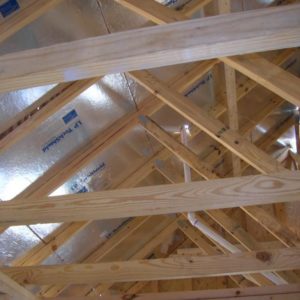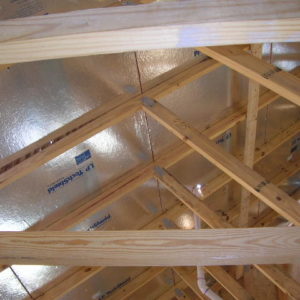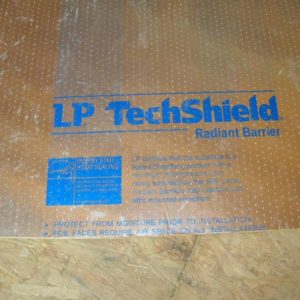Just had a house framed some weeks ago and used a new to me product – radiant barrier roof sheathing. Here is the web site for the specific product I used. As simple as it is, this stuff is kinda mysterious to me… Obviously it is for homes in warmer climates. I’m in Raleigh NC. I’m thinking the further south, the better the return.
Here is the thing though… These houses I’m building are to be Energy Star certified. The program works on a point system. For installing the radiant barrier, I get the same number of points as I do for upgrading the wall and ceiling insulation. They give you a sheet specific for your house and location with the point values for all the upgrades they recommend you to choose from, complete with monthly, annual, and 20 yr projected savings. This is reflected in the projected cost savings per year for the 2 different improvements: radiant barrier projected savings: $45.72/yr. Upgrade wall insulation and ceiling insulation projected savings : $45.72. I’m thinking the $ value is really based on the points…. Anyway, here is the kicker:
Cost to upgrade to radiant barrier sheathing: $ 99 (3 points)
Cost to upgrade insulation: $410, (estimated) (3 points)
The actual insulation is $365 but then I have to get ceiling board rated drywall to support the extra insulation weight, so that is why the insulation upgrade is estimated. Also I’ll mention that this is a modest sized house (1325 ht sq ft) so it only takes 30 pieces of roof sheathing on the main roof. Obviously I didn’t do the front porch and unheated attached shed. The cost numbers are from actual material costs – except that I haven’t ordered the drywall yet.
So, for the same projected energy savings, I can buy the radiant barrier sheathing or the insulation for 4x the cost. Is this a no-brainer or what??? I hate that term, but sometimes it fits.
Here is the kicker though (OK the 2nd kicker). The radiant barrier sheathing is no trouble at all to use. I asked the framers and they said it made no difference to them. Only thing I gotta do is order it and tell em “shiny side down”. With the drywall, for example, I gotta make sure they put the ceiling board on the ceiling, not on the walls – it looks nearly identical. Plus for the ceiling insulation we gotta frame the attic platform higher and I didn’t even add the extra lumber for that…
As a reference I can get the same 3 points for installing 100% florescent lights – wouldn’t want to do that… or the 3 points for upgrading from 13seer to 14 seer AC unit (+$475) (~$150 a point) or spray foam insulation would get me 8 points which I’m guesstimating would cost about $3k extra or $375 per point… radiant barrier – $33 a point.
I’m impressed with the radiant barrier – great value…
Thoughts??
Pics attached in both low res and higher res…
























Replies
Hi Matt
I'm over here in Chapel Hill, right to the left of you. we actually use the tech shield on our porches only because we use spray foam on our roofs. I agree that it is an amazing product. and the cost is minimal. Makes for nice cool front and screen porches for us.
m
------------------
"You cannot work hard enough to make up for a sloppy estimate."
Next time I'll use it on the porches too.
Care to comment on this type of sheathing product?
Also, regarding the staple-up roll foil product you describe in another thread, my guess would be it would be extremely hard to install this very well in a trussed attic - like for example the one shown in the pictures in my .1 post above. Seems like it would be rather labor intensive too? Thoughts?
I'm guessing this stuff is pretty popular in Texas...
It adds less than $.20 sq. ft. to the cost of the sheathing. There are no additional labor costs. It does work.The staple up radiant barrier would not be my choice for a trussed attic. The RB sheathing for new construction, or the RB paint for existing structures would be a better choice.I used the RB sheathing in my house. I built my house going through Owner Builder Network, and the RB sheathing was part of the standard lumber take off. I also have R49 cellulose in my attic, and none of my duct work is up there, so it is less of an issue for me than for most houses in this part of the world.
You confirmed my thoughts...
One of the Energy Star guys said I could retrofit one of the attics with staple up RB no problem. My response: it is a trussed roof and there are those diagonal 2x4 webs all in the way. His response: yea - that would make it a little more work. My response: I'd charge someone $300 or $400 to go to that much trouble... (small, simple roof). I talked to my insulator and he said they would do it but he highly discouraged it.
At this point I'm as pleased as punch with the RB sheathing. Wish I had done it on all 3 of the houses I'm currently building.
The one thing I don't quite get about the RB sheathing though is that I thought radiant barriers needed air space to work properly - presumably on both sides. If you look at the pics I posted it even says it needs air space right on the product... ???
"The one thing I don't quite get about the RB sheathing though is that I thought radiant barriers needed air space to work properly - presumably on both sides. If you look at the pics I posted it even says it needs air space right on the product... ???"As the label says THE FOIL FACES.Most people think that RB's reflect radiant energy because they usually have a shinny (reflectice) surface.Any "hot body" gives off and receive radiant energy. It is based on the absolute tempature of the body. IIRC to the 4 power of the abs temp.The other factor is the absorbtion of the surface of the material for how much energy that it will reflect energy from another surface and emissivity for how much it will give off radiant energy.Surfaces with a high reflectivity also have a low emisivity.Thus the RB could have been installed shinny surface up, with an air space, and it would refect the radiant energy back to the sun. But this has 2 problems. First is spacing it from the shingles and 2nd is it collecting dust which reduces it reflectivity.Or shinny down. In that case the shingles are heated and conducted tot the sheating. But with the sheating having a low emisive surface it does not act as a source of radiant energy to heat up the attic "floor" and equipment in the attic.There will still be heating of the attic from conductive heating of the air and convention will move that around. But venting will help reduce that..
.
A-holes. Hey every group has to have one. And I have been elected to be the one. I should make that my tagline.